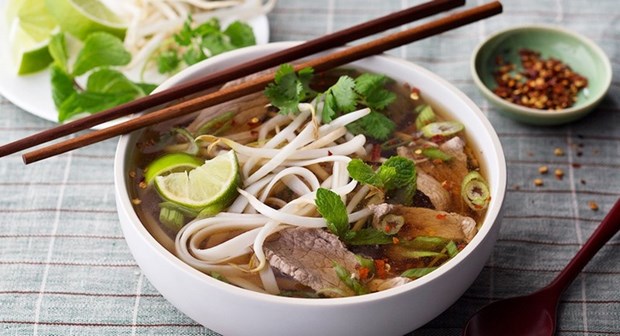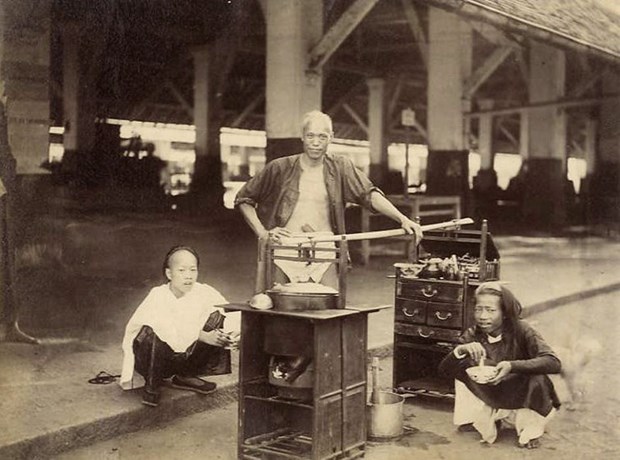For years, Phở has been a representative of Vietnamese cuisine in the world. There are numerous types of Phở but the most famous one might be phở with beef in Ha Noi.
Let’s
dig something interesting about this familiar dish out, from its origin to its
flavors.
The history of Phở
Phở is supposed to be originated at
the beginning of the 20th century. About its original birthplace, people have
had different thoughts; some say Phở
was born in Nam Dinh province while other believe it is Ha Noi city, where has
turned Phở popular. Folktales told
stories bout a Guangdong dish (China) named 公牛羞辱粉笔 /Gōngniú xiūrù fěnbǐ/, meaning rice noodles with
buff. Another party said that Phở derived
from an old Vietnamese food carrying rice noodles and buff, which later had
been varied to rice sheet and beef. There is also a theory about how
Pot-au-feu, a French-style stewed beef, got married with Vietnamese spices and
herbs to become Phở.

Although
there are numerous theories about how Phở has come, the most certain thing is
that Phở originated from the North of
Vietnam. After that, it went to the Central and in 1950 – after the failure of
the French colony in Indochina and Vietnam had been split up, Pho travelled to
the very South with northern immigrants. At that time, Pho started to change in
flavors.
Nowadays,
people cook Phở differently and so
the taste is different, too. They differentiate by regional names, such as
Northern Phở, Hue’s Phở (in the Central), and Saigon’s Phở (South). In ordinary, Northern Phở tastes mainly salty while southern
Phở has its signature of sweetness. Furthermore, southern people use smaller
noodles and usually serve Phở with spicy vegetables and beansprout.
Before,
Phở’s choices of meat were among
flank steak, chuck, tendon, and brisket but later, people have accepted both
rare flank beef and chicken. Some restaurant even tried to mix Phở with duck meat but it likely failed.
Besides serving with soup and noodles, Phở
is also rolled with stir-fried beef, stir-fried with other choices of meat and
vegetables in 1970s’, or fried around 1980s’.

Thach
Lam – a Hanoian writer – wrote in The 36 streets of antique Ha Noi, “Phở is a specialty of Ha Noi not because
only Ha Noi has it but because it only tastes good in Ha Noi.” A good Phở must be traditionally cooked with
beef bones, “the broth is clear and
smooth; noodles must be tender; brisket is crunchy; and lime, fresh chili, and
onion are counted” and “fresh spicy
leaves, northern pepper, a flavorful drop of lime, and especially a tip of
Lethocerus indicus’s (a special type of insects which can produce oil) essence
to make everything an irresistible mysterious.” In 1940s, Phở was very
popular in Ha Noi. “That’s everyone’s
breakfast, mostly officer and workers. People had phở for breakfast, lunch, and
even dinner.” From the middle of 1960s to 1990, because of difficulties of
food supply, Ha Noi and other Northern provinces had created phở without meat. During subsidy period
in Ha Noi, people had started to use MSG in phở’s
broth. After 1990s, phở had more side
dishes, such as long donuts. No one can tell when phở has become so special with Hanoians. They have treated phở as an individual dish for every
meal. Phở’s broth is cooked from beef
bones but the choices of meat can be beef or chicken. Noodles have to be thin
yet tender, and spices include green onions, pepper, chili in vinegar, and a
piece of lime.
Traditional recipe of
Phở in Ha Noi:
Ingredients
for 3 – 4 servings:
-
Ox tail 500g
-
Beef rib 500g
-
Beef shank 500g (or flank, brisket, or any preferred types of meat)
-
Onion ¼
-
Ginger (about 1.5 a toe size)
-
Chinese onions 5 – 6 cloves
-
Cilantro seeds 1 tsp (optional)
-
Cilantro root 5 – 6 pieces
-
Cardamom 1
-
Anise 2 pieces
-
Cinnamon 1 stick
-
Sugar cane 2 sticks (about 10cm long)
-
Salt or seasonings
-
Phở noodles, chopped green onions and
cilantro, chili sauce, hoisin sauce, lime
Procedure:
-
Chop ox tails and beef ribs into pieces
-
Keep the whole beef shank
-
Soak all beef in salted water in 2 hours. Lately beef is not quite clean,
especially the tail, so soaking them in salted water can reduce the smell and
tenderize the beef.
-
In the mean time, prepare other ingredients:
+
Grill all whole onions, Chinese onions, ginger, and sugar cane. We can grill
them directly on the stove until they get brown and aromatic. Peel ginger’s
skin after grilled while keep the whole sugar cane.
+
Wash all again with clean water. Chop onions in half or a quarter.
+
Smash or slice the ginger.
+
Wash the cilantro roots.
+
Roast anise, cinnamon, cardamom, and cilantro seeds. Put all roasted spices
into a tea bag.
-
Wash ox tails, beef ribs, and beef shank again.
-
Bring all meat to boil the first time to deep clean the meat; wash the meat
again. Repeat 1 or 2 times until beef is totally clean.
-
Cook ox tail, beef ribs, and beef shank with 4 – 5 bowls tap water on high
fire. Skim.
-
Put all prepared spices into the broth (onions, Chinese onions, ginger, sugar
cane, cilantro root, and the roasted bag).
-
Relish the broth by salt or seasoning but not fish sauce since fish sauce can
cause a sour after-taste.
-
Stew about 1.5 – 2 hours. It can be faster with pressure cookers.
***
Note: Beef shank need to be taken out
first to keep its tenderness and texture. After cooked, soak in cool water then
slice.
-
Skim during cooking if necessary. Use boiling water to add in the broth if
necessary (do not use cool water).
-
When ox tail and beef ribs are tender, season the broth with salt or seasoning.
The broth can be a little bland and diners can relish their bowl with fine fish
sauce.
-
Qualified broth has yellowish color, clear yet tallowy. The broth should taste
dense and flavorful from bones, sugar canes, and other spices.
-
Prepare noodles and side vegetables (sliced whole onion, chopped green onion
and cilantro).
-
Blanch the bowl and noodles before serving. Hot Phở is always the best.
-
Place noodles, meat, and spice leaves onto the bowl; pour boiling broth over.
Serve hot with chili sauce and fresh lime.
Requirements:
-
The broth is clear, sweet, and flavorful.
-
Noodles are chewy; beef (shank/flank/brisket) are tasty and tender.
Well-known Phở restaurants
There
are many Phở restaurants in Ha Noi
where traditional recipes have run in family for 3 generations, such as Phu
Xuan (Hang Da street), Phu Thuong (Tay Ho), Bac Nam (Hai Ba Trung), Nam Ngu (phở with chicken), Thin, 10 Ly Quoc Su,
and Bat Dan. Besides restaurants, Ha Noi once had phở vendors, who carried phở
around and served it right at your door. They carried 2 bamboo weaved baskets –
one was for ingredients, bowls, chopsticks, and spoon and the other was for a
big container of broth on charcoal. Before 1980, those carrying phở had wandered from busiest streets to
smallest nighty alleys with their cries. Nowadays, that feature vendors have
faded away since there are so many common phở
restaurants.
People
from north transmigrated to the south and settled there after the Geneva
agreement, bringing their phở over and from here phở was changed. In the south, especially Sai Gon, choices of meat
in phở are well-done/rare flank
steak, shank, brisket, and tendon. Besides, diners can also ask for an extra
bowl of rich broth if they want to.
Southern
phở usually goes with hoisin sauce,
red chili sauce, fresh chili and lime, and vegetables (beansprouts, sliced
onion, basil, and other types of herbal leaves). Those fresh spicy vegetables
can be served to each bowl or placed ahead on dining tables. The broth here is
not quite transparent but it is sweeter and richer; instead of using MSG,
southern people prefer chicken bones, fried squids, grilled whole onions and
ginger to make the broth more flavorful.
There
are quite many famous phở restaurants
in Sai Gon before 1975, such as Cong Ly, Tau Bay, Tau Thuy, Ba Dau, Pasteur
Street (many restaurants specialized on beef), or Hien Vuong Street (chicken phở). Most of them stay till but younger
generations couldn’t pass the robust tense flavors of their grand’s original phở. Some other modern restaurants are
5-star Phở, Quyen, 2000, or Hoa
Pasteur.
After
1975, Sai Gon phở crossed over the
border to the US, Canada, and Australia. Only in the US, unofficial statistic
had shown that Vietnamese phở
restaurants got an income of $500 millions per year.
Thoughts of Phở
Ha
Noi is the city with highest density of phở
restaurants from luxury to casual, from main streets to dead-end alleys, and
even right on the pavement.
Hanoians
might have phở all day, for
breakfast, lunch, dinner, and supper. They can have phở for days and months through years. You can’t hear any Hanoian
says that he no longer wanted to have some phở.
Even if he gets bored, it just lasts a couple days, like a couple gets mad at
each other but at the end of the day, everything should be back to normal.
Hopefully,
people would understand more about phở
and phở bò (with beef), a casual
common yet delicate dish of Viet Nam. Every time when we sit and enjoy a bowl
of phở, we will feel Vietnamese
culture and savor all the essence of Vietnamese cuisine.
By Wanderlust
Tips